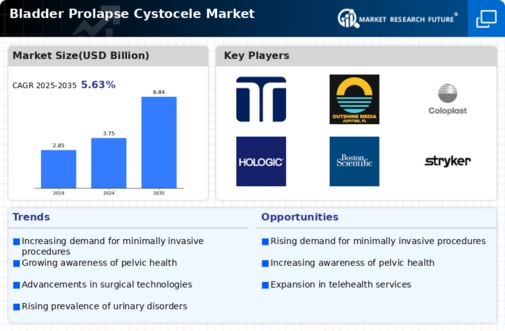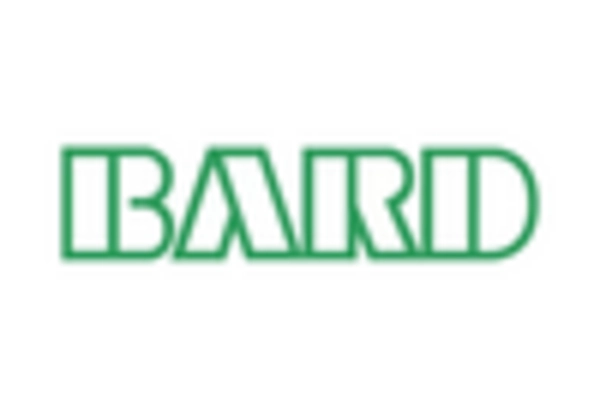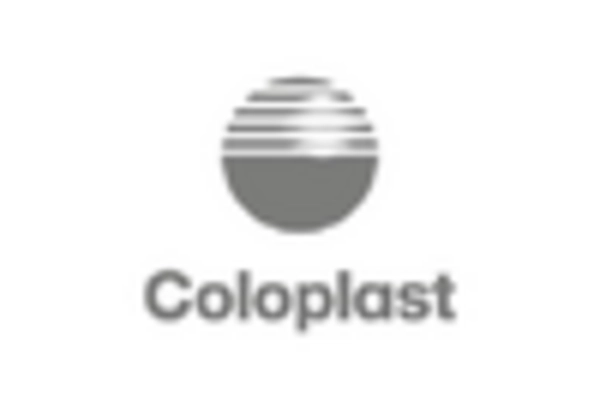Growing Awareness and Education
Increased awareness and education regarding bladder prolapse and its treatment options are driving the Bladder Prolapse Cystocele Market. Campaigns aimed at educating women about pelvic health have led to a greater understanding of the condition and its implications. Healthcare providers are also emphasizing the importance of early diagnosis and intervention, which encourages patients to seek help sooner. This heightened awareness is reflected in the rising number of consultations and treatments for bladder prolapse. As more individuals become informed about their options, the demand for both surgical and non-surgical treatments is expected to rise, positively impacting the Bladder Prolapse Cystocele Market.
Increase in Healthcare Expenditure
The rise in healthcare expenditure across various regions is a significant driver for the Bladder Prolapse Cystocele Market. As governments and private sectors invest more in healthcare infrastructure and services, access to treatment options for bladder prolapse improves. This increase in funding allows for better diagnostic tools, advanced surgical techniques, and comprehensive patient care. Furthermore, as healthcare systems evolve, there is a growing emphasis on women's health, which includes addressing conditions like bladder prolapse. Consequently, the enhanced financial resources allocated to healthcare are likely to stimulate growth in the Bladder Prolapse Cystocele Market.
Advancements in Surgical Techniques
Innovations in surgical techniques and technologies are transforming the Bladder Prolapse Cystocele Market. Minimally invasive procedures, such as laparoscopic and robotic-assisted surgeries, have gained traction due to their benefits, including reduced recovery times and lower complication rates. These advancements not only enhance patient outcomes but also encourage more healthcare providers to adopt these methods. The introduction of new surgical instruments and materials, such as mesh implants, has further expanded treatment options. As a result, the market is witnessing a shift towards these advanced surgical solutions, which are likely to dominate the Bladder Prolapse Cystocele Market in the coming years.
Rising Incidence of Bladder Prolapse
The increasing prevalence of bladder prolapse, particularly among women, is a notable driver for the Bladder Prolapse Cystocele Market. Factors such as aging, obesity, and childbirth contribute to this condition, leading to a higher demand for treatment options. According to health statistics, approximately 30% of women experience some form of pelvic organ prolapse in their lifetime. This rising incidence necessitates the development and availability of effective therapeutic solutions, thereby propelling market growth. As awareness of bladder prolapse increases, more individuals seek medical advice, further driving the demand for surgical and non-surgical interventions in the Bladder Prolapse Cystocele Market.
Emergence of Non-Surgical Treatment Options
The emergence of non-surgical treatment options is reshaping the Bladder Prolapse Cystocele Market. Non-invasive therapies, such as pelvic floor exercises, pessaries, and lifestyle modifications, are gaining popularity among patients seeking alternatives to surgery. These options are particularly appealing to those who may be hesitant to undergo surgical procedures due to potential risks or recovery times. The availability of these treatments not only broadens the market landscape but also caters to a diverse patient demographic. As more individuals explore non-surgical avenues for managing bladder prolapse, the demand for these solutions is expected to grow, influencing the overall dynamics of the Bladder Prolapse Cystocele Market.

















Leave a Comment